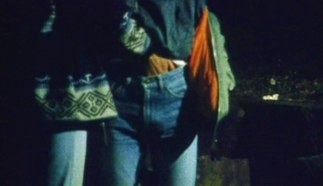the shooting star
by Douglas Messerli
Hiroyuki Oki (screenplay and
director) あなたが好きです、大好きです(Anata-ga suki desu, dai suki desu) (I Like You, I Like You Very Much) / 1994
Plot is not a significant element of
Japanese director Hiroyuki Oki’s challenging “Pink”* film of 1994, Anata-ga
suki desu (I Like You, I Like You Very Much). In fact, there isn’t
actually a narrative plot in this film in the usual way in which
we conceive it. A few things happen: waiting at a station for a train in order
to return home, Yu encounters a somewhat beefy guy, Taka, waiting on the bench
with him and apparently falls immediately in love, running after him when they
reach their destination in Kochi to report: “I like you, I like you very
much”—words I’ve been told by Asian film scholar Earl Jackson that in the
Japanese, suki desu, mean something much stronger than a mere
“liking.”
In any event, the boys soon after are observed in Taka’s apartment
having sex, seeming to ejaculate several times, at one point when the cum is
visible on Taka’s upper chest, Yu preventing him from wiping it up as he leans
into hug and kiss him again and again, finally licking up the sticky residue
with his tongue.
In the morning the two, Yu and Shin, come back together realizing that
they love one another far deeper than any of the other temporary sexual
experiences they have had in the hours previous, watching the “hot” and
apparently straight Taka passing on his daily run by the field in which they
have laid out sheets to breakfast upon. As one commentator observes, this “soft
porn” film ends in a completely romantic note.
If that’s all there is, many viewers will be terribly disappointed
watching this film—as many obviously were in their early comments about the
work. Although there is lots of sex, as Andrew Grossman writes in Bright
Lights Film Journal:
“I Like You’s shadowy sex
scenes are a muddle of lifeless realism and private intensity, combining
organic, naturally recorded sounds with looped panting. In a Japan where the
penis is (more or less) verboten, the sex never dares to cross the threshold of
hardcore; as is frequently the case with Japanese erotica, however, neurotic
censorships only facilitate fetishes that would not otherwise exist. Most
conspicuously, Shin’s jockstrap serves not only the pragmatic function of
camouflaging genital taboos, but becomes a nearly metaphysical totem that
crystallizes the longings of those who gaze upon it. Though at times
excruciatingly tedious, the film’s monotonous seaside atmosphere lingers in the
memory, and the tedium does eventually blur into a kind of melancholic relaxation,
even if the undernourished characters who populate this milieu remain as alien
to us as they are to each other.”
Actually, I found Oki’s hand-held camera swirling around the sweaty
bodies of Yu and Taka as they fuck again and again—emptying themselves of
everything other than physical contact in a
For in contradiction to his world of temporary bliss is the world in all
of these various lovers exist. The coastal town of Kochi, primarily a fishing
and agricultural center, is a bleached-out village—the fact of which Oki’s
overexposed outdoor images constantly accentuate—wherein everyone seems to live
in ramshackle three-to-four story apartment complexes whose major access are
the winding backyard paths over which are flung lines of drying shirts and
pants and which are themselves lined by garbage bins. The town center, such as
it is, seems to be a dusty, telephone-lined street with fast-food restaurants
almost in the manner of many US Midwest burgs. There is little here for
individuals like Taka, Shin, Yu, and Yu’s ex-lover to do but to engage in sex.
Compared to the marvels of Tokyo and Kyoto, Kochi might as well be on another
planet.
In this world all the boys seem to have the poster for US director Gregg
Araki’s The Living End on their walls, suggesting their commitment to
what critic B. Ruby Rich has described as the New Queer Cinema with
which this fascinating film, as well as its character’s lives, have little in
common. But the dangerously humorous “on the road” adventures of Araki’s film
seems a suitable goal for these aimless boys who use sex as their link to the
world of beauty and pleasure their society seems unable to provide.
*Japanese “Pink” films, most often
heterosexual in nature but also, at times, homosexual, are quickly made and
inexpensively filmed works that feature sex and violence, while sometimes
bordering on pornography. Held in low esteem in Japan, they have nonetheless,
become cult favorites and many of their directors have been able through these
films to move into the more established cinema filmmaking. For some directors
the grade B- Pink films have almost served as a badge of their disinterest in
establishment film.
Los Angeles, August 27, 2022
Reprinted from World Cinema
Review (August 2022).






No comments:
Post a Comment